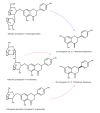Beneficial effects of naringenin in liver diseases: Molecular mechanisms
- PMID: 29713125
- PMCID: PMC5922990
- DOI: 10.3748/wjg.v24.i16.1679
Beneficial effects of naringenin in liver diseases: Molecular mechanisms
Abstract
Liver diseases are caused by different etiological agents, mainly alcohol consumption, viruses, drug intoxication or malnutrition. Frequently, liver diseases are initiated by oxidative stress and inflammation that lead to the excessive production of extracellular matrix (ECM), followed by a progression to fibrosis, cirrhosis and hepatocellular carcinoma (HCC). It has been reported that some natural products display hepatoprotective properties. Naringenin is a flavonoid with antioxidant, antifibrogenic, anti-inflammatory and anticancer properties that is capable of preventing liver damage caused by different agents. The main protective effects of naringenin in liver diseases are the inhibition of oxidative stress, transforming growth factor (TGF-β) pathway and the prevention of the transdifferentiation of hepatic stellate cells (HSC), leading to decreased collagen synthesis. Other effects include the inhibition of the mitogen activated protein kinase (MAPK), toll-like receptor (TLR) and TGF-β non-canonical pathways, the inhibition of which further results in a strong reduction in ECM synthesis and deposition. In addition, naringenin has shown beneficial effects on nonalcoholic fatty liver disease (NAFLD) through the regulation of lipid metabolism, modulating the synthesis and oxidation of lipids and cholesterol. Moreover, naringenin protects from HCC, since it inhibits growth factors such as TGF-β and vascular endothelial growth factor (VEGF), inducing apoptosis and regulating MAPK pathways. Naringenin is safe and acts by targeting multiple proteins. However, it possesses low bioavailability and high intestinal metabolism. In this regard, formulations, such as nanoparticles or liposomes, have been developed to improve naringenin bioavailability. We conclude that naringenin should be considered in the future as an important candidate in the treatment of different liver diseases.
Keywords: CCl4; Cirrhosis; Fibrosis; Flavonoids; Hepatic stellate cells; JNK; Liver; MAPKs; Naringenin; Smads; Transforming growth factor; α-SMA.
Conflict of interest statement
Conflict-of-interest statement: The authors declare no conflicts of interest.
Figures









References
-
- Muriel P. The liver: General aspects and epidemiology. In Muriel P. Liver pathophysiology: therapies & antioxidants. Waltham, MA: Elsevier; 2017. pp. 3–22.
-
- Lozano R, Naghavi M, Foreman K, Lim S, Shibuya K, Aboyans V, Abraham J, Adair T, Aggarwal R, Ahn SY, et al. Global and regional mortality from 235 causes of death for 20 age groups in 1990 and 2010: a systematic analysis for the Global Burden of Disease Study 2010. Lancet. 2012;380:2095–2128. - PMC - PubMed
Publication types
MeSH terms
Substances
LinkOut - more resources
Full Text Sources
Other Literature Sources
Medical
Research Materials

